Dubai
2008
Pictures and Articles Collected by Rick Archer
Published January 2008
It has been two years since I published my
first stories about Dubai. Recently I realized that in just
two short years there has been quite a bit of new development in
this city that seems more science fiction than real.
Some of the newest pictures are so amazing, it is hard to
believe this is really happening. So it is time for an update. You are in for a treat.
Included along with the pictures are two business articles about the
development.
|
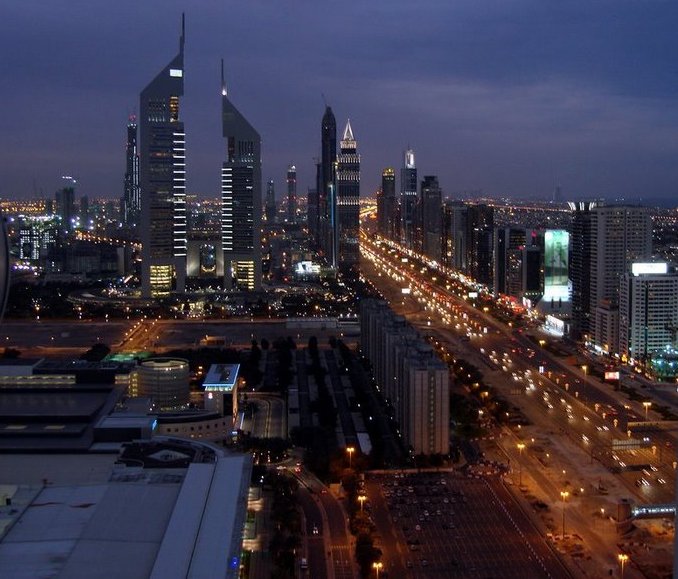 |
|
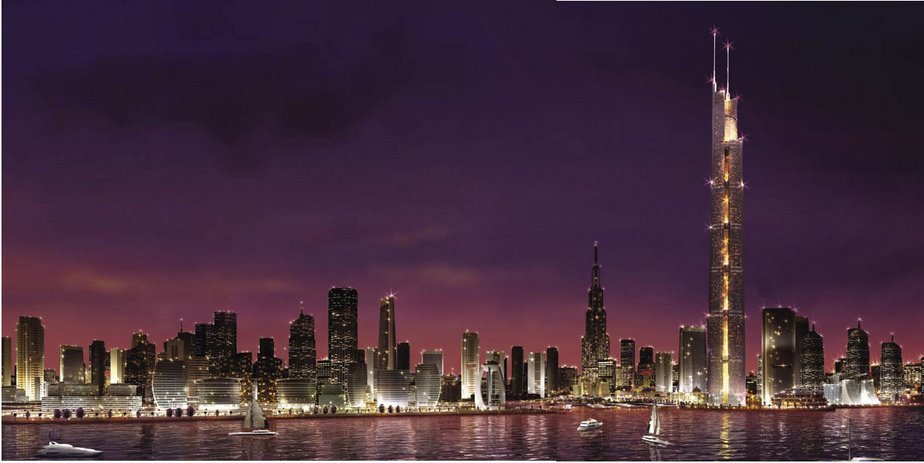
Dubai's
Architectural Wonders
By Reena Jana
for Businessweek
MARCH 2, 2006
As oil reserves dwindle, Dubai's attention-grabbing
construction projects, including an underwater hotel, are
aimed at drawing tourist dollars
There's more than one Dubai drama playing out on the world
stage these days. Besides the fracas over whether U.S. ports
should be overseen by Dubai Ports World (see BW Online,
3/6/06, "The Real Shipping News") the emirate is gaining
widespread attention and generating buzz in architecture,
design, and real-estate circles. Dubai, one of the seven
United Arab Emirates, is engaged in a building boom of epic
proportions.
By the beginning of the next decade, relatively tiny Dubai
-- it's smaller than Canada's Prince Edward Island, and has
a population of about 1.4 million citizens -- will be home
to an astonishing number of superlative architectural
projects. These include Earth's tallest skyscraper, the
first luxury underwater hotel, and a man-made archipelago of
private, residential islands (yes, the biggest development
of its kind) that will resemble a map of the world when seen
from above.
|
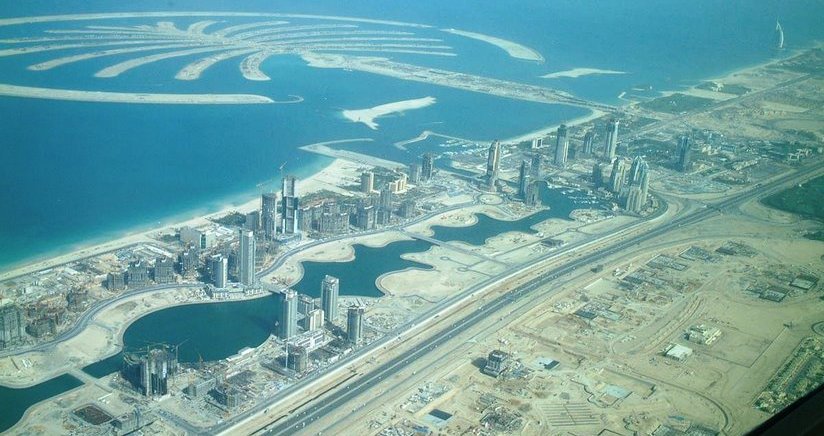
According to Wikipedia, the
Dubai Waterfront is expected to become the largest
waterfront and largest man-made development in the
world. The project is a conglomeration of canals and
artificial islands; it will occupy the last
remaining Persian Gulf coastline of Dubai, the most
populous emirate of the United Arab Emirates. It
will consist of a series of zones with mixed use
including commercial, residential, resort, and
amenity areas. The vision of the project is "to
create a world-class destination for residents,
visitors and businesses in the world's fastest
growing city".
|
The vision of Dubai Marina is to create an awe-inspiring
city-within-a city that delights residents with its cosmopolitan,
free-spirited atmosphere and unique, invigorating lifestyle.
It will be an urban centre on the water, comparable to
the most exclusive waterfront developments in the world's leading
cities. Ideally positioned along Dubai's new growth corridor, Dubai
Marina will be the place where people meet, laugh, live and enjoy
life to the full. Some of the tallest buildings in the world, such
as Ocean Heights and The Princess Tower, which will be the largest
residential building in the world at over a 100 stories, will line
the Dubai Marina.
|
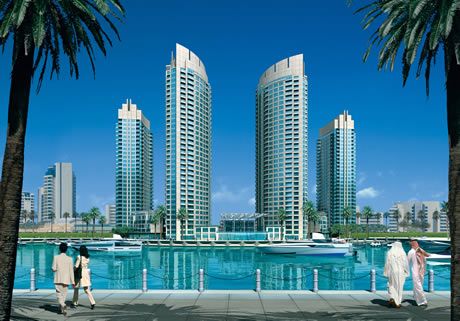 |
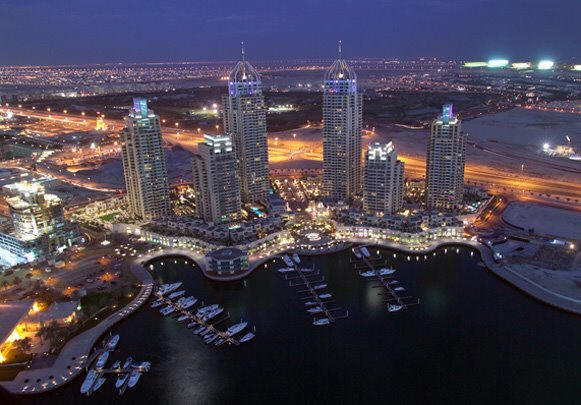 |
Always alive, with the glittering Marina at its heart, Dubai
Marina will be unlike any other place, in Dubai, the Middle East and
even the world.
The Dubai Marina is an entirely man made development that will
contain over 200 highrise buildings when finished.
It will be home to some of the tallest residential structures in the
world. The completed first phase of the project is shown. Most of
the other high rise buildings will be finished by 2009-2010.
|
Most of Dubai's ambitious building projects are in planning
or early construction stages. The emirate's current skyline
is dotted with cranes. According to the most recent study
published by the Dubai Chamber of Commerce & Industry,
Dubai's construction and building sector contributes 12.2%
of the emirate's non-oil GDP and has grown annually at an
average rate of 27%.
CONSPICUOUS CONSTRUCTION. Why the sudden construction boom?
Dubai's Crown Prince, Sheikh Mohammed Bin Rashid Al Maktoum,
who is also the Defense Minister of the United Arab Emirates
and the president of the Dubai Development and Investment
Authority (DDIA), has set a goal to attract 15 million
tourists in the year 2010 (up from 5.24 million in 2003).
Interestingly, that's the same year that, according to The
Economist, Dubai's known oil reserves will be tapped.
The DDIA reports that today, 90% of Dubai's diversified
economy is fueled by non-oil sectors, indicating that Dubai
is clearly racing to fuel new industries such as tourism. To
rev up its tourism industry, Dubai's developers are engaged
in an intense reshaping of the urban landscape.
The ambitious scale and breakneck pace of building echoes
what's happening in China, a much, much larger nation
engaged in its own race to redefine its skylines (see BW
Online, 12/23/05, "China's New Architectural Wonders") in
preparation for the 2008 Olympic games. As if competing in
an unofficial architectural Olympics, Dubai is striving to
break as many records as it can in terms of "tallest,"
"largest," or, simply, "first."
Dubai's developers hope to win tourists
not only from the Middle East, but from Europe and even
Asia, where rapid economic development is creating a new
wealthy class.
If all goes as planned, there will be plenty for future
tourists to capture in keepsake digital photos.
Ski Dubai, which is already open, is not only the
only place to ski in all of Arabia, it is the largest indoor
skiing facility in the world.
The picture on the right is a rendered
image of yet another future indoor skiing
facility that is being planned.
|
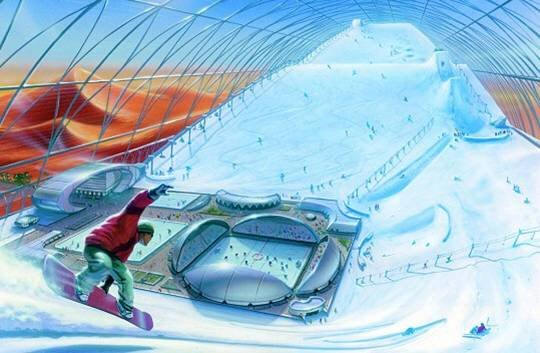 |
The UAE Spaceport would be the first spaceport in the
world if construction ever gets under way. The Dubai Metro
system, once completed, will become the largest fully
automated rail system in the world. The
Dubai World Central International Airport will become the
largest airport in size when it is completed. It will also
eventually become the busiest airport in the world, based on
passenger volume. There are more construction workers in
Dubai than there are actual citizens.
Dubai will
soon be home to world's tallest building, the sleek and
spectacular Burj Dubai, designed by American firm Skidmore,
Owings & Merrill (SOM). When it is completed in 2009, it
will knock Taiwan's pagoda-shaped Taipei 101 from its roost
as Earth's loftiest. Another Western firm, Britain's Foster
& Partners, has designed One Central Park, a mixed-use,
eco-friendly building 80 stories high.
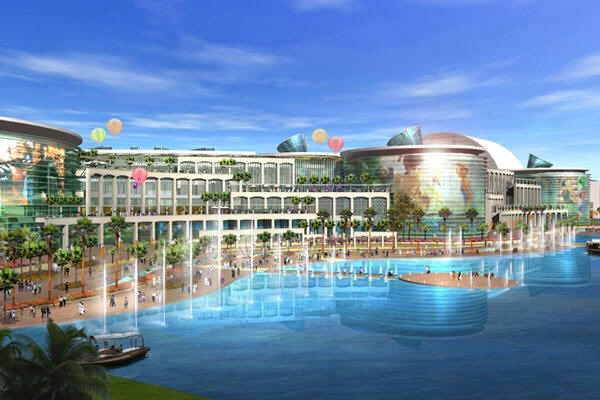 |
One Central Park will be the world's highest residential
apartment building when it opens its doors in 2008.
Singapore's DP Architects have designed the 1,000-store
Dubai Mall.
The Dubai Mall will be the largest shopping mall in the world with
over 9 million square feet of shopping.
When it opens in 2008, it will be the biggest shopping center
on the planet.
|
While impressive, these structures are
rather traditional compared to some of the construction
efforts in Dubai.
There's Hydropolis, an underwater hotel
developed and designed by Germany's Joachim Hauser.
Entirely built in Germany and then assembled in
Dubai, it is scheduled to be completed by 2009 after
many delays.
And there's Palm Islands, a set of man-made resort
islands shaped to look like a palm tree when seen
from a jet, which will open later this year.
|
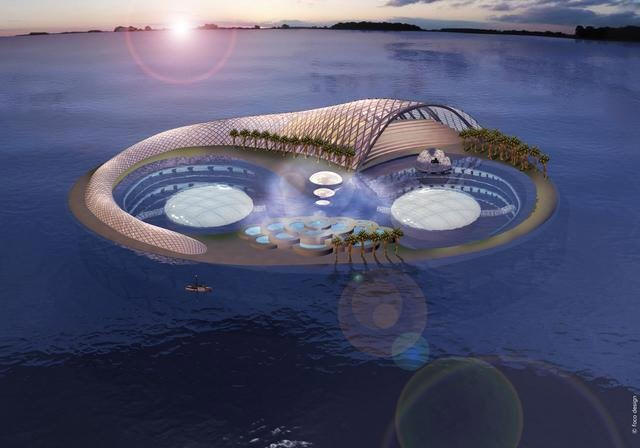 |
This year the same developer will also complete
The World, a series of manufactured residential islands
that, when seen from above, resemble smaller versions of the
seven continents.
And speaking of space, the American firm Space Adventures
(known for launching the first civilian orbital space
flights) is developing the UAE spaceport, the first
commercial spacecraft flight center in nearby emirate Ras
Al-Khaimah, minutes away from Dubai. Dubai's citizens, no
doubt, will consider the UAE spaceport their hometown
spaceport, just as New Yorkers look upon Newark Airport, in
nearby New Jersey, as one of their local hubs. No completion
date has been set for the spaceport.
That Dubai is pushing for extreme architecture shouldn't
come as a surprise if you look at the emirate's history of
firsts. In 1979, the biggest man-made port opened at Jebel
Ali in Dubai, and in 1999, Dubai became the site of the
world's first 7-star hotel, when the iconic, sail-shaped
Burj Al-Arab opened for business.
WORLD WORLD. A particularly ambitious project in the works
is Dubailand, partially funded by Dubai's government and
developed by Dubailand LLC. It's a massive, sprawling, and
totally built-from-scratch city-as-tourist attraction that
suggests the theme-park atmosphere of Disneyworld (DIS) or
Las Vegas, only more so. Located only 10 minutes from the
Dubai International Airport, Dubailand will cover 3 billion
square feet and feature six different "worlds."
Dubailand's more "conventional" family-oriented offerings
are Attractions and Experience World, devoted to roller
coasters, waterslides, and other mechanical rides; Sports
and Outdoor World, with a variety of stadiums (designed by
German architectural firm von Gerkan Marg & Partner) and
other athletic venues; and Downtown, which will be a
downtown center with movie theaters, restaurants, and
bowling alleys.
Eco-Tourism World, which will present "natural" environments
and biosphere structures, promises to be the most
forward-thinking offering. Leisure and Vacation World -- a
spa environment, and Retail & Entertainment World, which
will house low-end to high-end retail, seem to be giant
playgrounds for grownups. Currently, initial infrastructure
(utilities, roads) is being built, and the goal is to have a
portion operational by 2008.
While all of Dubai shouldn't be conflated with Dubailand and
its pure entertainment value, it's clear that the emirate
will soon be overflowing with attractions, whether
amusement-park rides or serious architecture. Like Las
Vegas, Dubai's dramatic new developments won't be without
their critics. Love them or hate them, these new wonders of
the world are just that -- wonders.
|
Boom Town
Adam Nicolson
Reprinted from
The Guardian
Monday February 13 2006
The fastest-growing city on earth, Dubai is spending
mind-boggling sums on construction and is about to swallow up P&O in
its bid to be a global maritime power. Given the scale of its
ambition, could it become the most important place on the planet?
It looks like a hot Grozny. On the vast
invented islands offshore and in the even vaster building sites that
stretch in a wide band the whole length of Dubai's now famous
riviera, acre on acre of grey-faced, concrete, hollow-eyed
buildings, fenced in with scaffolding and overhung by tower cranes,
stare at each other across the sands. Tower
blocks look abandoned rather than half-made.
|
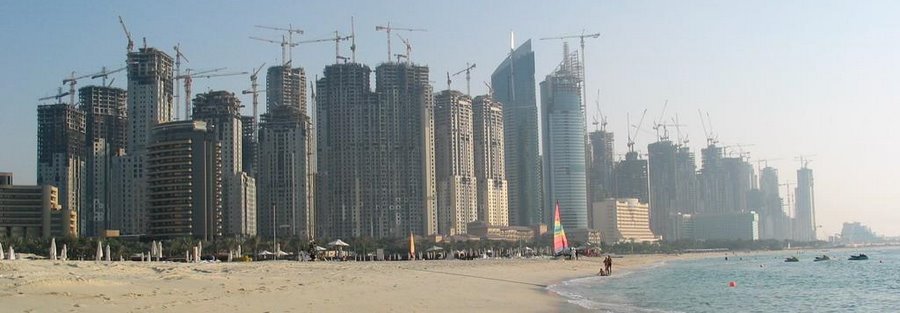
Dubai is said to
currently have 15-25% of all the world's cranes
in use during its massive construction phase.
|
It is said that a fifth of the world's cranes are now at work
here. An army of some 250,000 men, largely from India and Pakistan,
are labouring to create the new glimmer fantasy, earning on average
£150 a month, and living in camps, four to a room, 12ft by 12ft,
hidden away in the industrial quarters of al Quoz. One night in one
of the luxury hotels would cost six months' wages of one of the men
who built it. Below and around their work sites, the new streets are
chaotic with rubble and piles of steel.
|
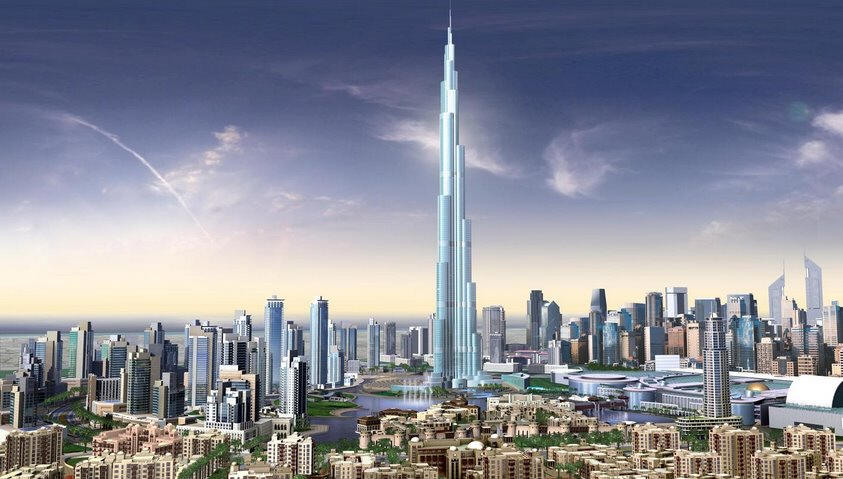 |
The traffic is already as bad as Los Angeles. The city
authorities are now giving priority to new roads, hundreds of
millions of dollars are being spent on bridges across the Dubai
Creek, five lanes in each direction, but still a taxi ride that
might take 10 minutes at midday lasts an hour at either end of it.
If you ask a driver to take you to some places, he laughs. "Do you
want to have a very long talk?" he says.
Dubai is growing faster than any city on earth. "Mushroom City",
Ravi Piyush, a plumply content dealer in the Gold Souk, said to me.
"Nothing today, everything tomorrow." The World Bank reckons that
the reconstruction of Iraq is going to cost $53bn. Here, along the
strip of footballer-friendly sand that stretches 25 miles or so
along the shores of the Persian Gulf, there is, at a rough estimate,
about $100bn worth of projects either underway or planned for the
near future. That is a numbing figure, ungraspable. It is the
equivalent of every single dollar invested in the United States from
abroad last year; almost twice the foreign investment in China.
There are the three famous offshore "Palm
Islands". The Palm Islands
in Dubai are the largest
artificial islands in the world. They
can be seen from space. New
Dutch dredging technology was used to create these massive
man made islands.
Three of these Palms will be made with the last one being
the largest of them all. These
man-made peninsulas are
laden with more hotels and more "signature villas" than the
entire Premiership might ever dream of.
Upon completion, the resort will have 2,000 villas, 40
luxury hotels, shopping centers, movie theaters, and many
other facilities. It is expected to support a population of
approximately 500,000 people.
|
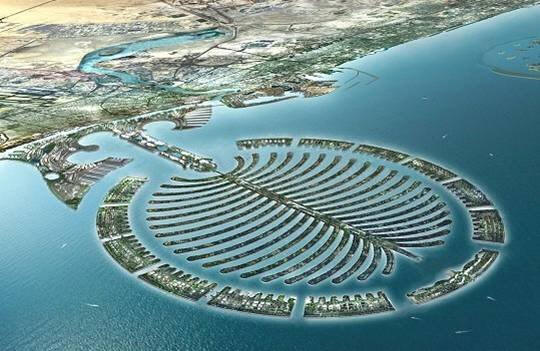 |
The 7,000-man workforce on one of them is too large to get on to
the palm each morning without creating its own traffic jam: they are
shipped in by sea from further along the coast.
There's the tallest building in the world under
construction, Burj Dubai, costing $800m.
Set to become the world's tallest skyscraper, the
$1.8-billion Burj Dubai will "set a new architectural
benchmark," said Mohamed Ali Alabbar,
chairman of state-controlled Emaar Properties, which is
building the tower.
It will be almost 40% taller than the
the current tallest building, the Yaipei 101.
A billboard the size of Piccadilly Circus stands out
in the desert showing the pencil-thin rocket of a tower
alongside a simple rubric: "History Rising."
However Emaar won't release Burj Dubai's
projected height for fear of being one-upped by another
developer with mine-is-biggest designs. It is
expected to be 800m tall when complete, but the precise
figure is being kept secret in case
buildings such as
New York's new Freedom Tower tries to top it.
The secrecy doesn't make much sense.
After all, Dubai has already released plans to build the Al
Burj Skyscraper.
(see picture below).
Recently it was announced that the final height of this
tower will be 1200 meters.
|
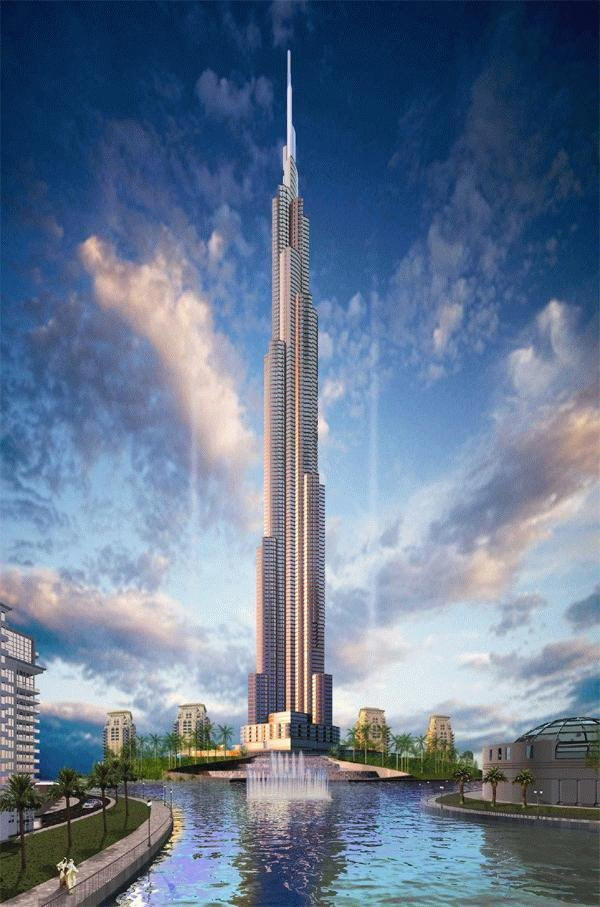 |
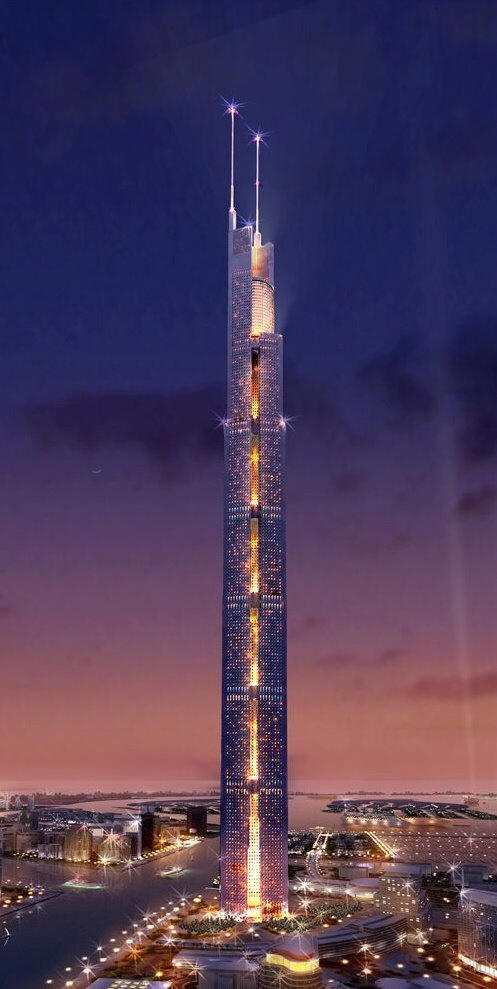 |
That would make it more than 30%
taller than the Burj Dubai and three times as tall as the
Empire State Building.
Once completed the Al Burj will take
over the title of the tallest structure in the world from
the Burj Dubai as it becomes the centerpiece of the Dubai
Waterfront. Besides the Al
Burj, there are all sorts of other projects either recently
finished, under construction or on the planning table.
For example, the biggest shopping mall
in the world is already here. Another, bigger, the world's largest
retail development, is
also under construction.
There's to be a Giorgio Armani Hotel and a Palazzo
Versace. There's to be an
underwater hotel ($500m). One indoor ski resort, with real
snow and its own black run, exists already, a weird, looming
presence on the city's southern skyline.
There is to be a second, with a revolving mountain. There's to be
a 60-floor apartment block in the shape of Big Ben.
Plans are mooted for a Chess City, with 32 tower blocks of 64 floors.
Each building will be made in the form of a chess piece
(no pictures available yet)
One company selling flats is giving away a free Jag with each
one.
There will be a pyramid and a building called Atlantis that will
cost $600m and include a "swim-with-the-dolphins encounter
programme".
Other coming attractions include an
Aviation City and a Cargo Village, an Aid City and a Humanitarian
Free Zone, an Exhibition City and a Festival City, a Healthcare City
and a Flower City.
|
Also in the works is a $4
billion extension to the airport.
In addition there is another entirely new airport along the
coast towards Abu Dhabi, for which no figures are available but you
can take a guess at a few billion: six runways, annual capacity 120
million passengers, 12 million tons of cargo. Next to it, as the
Dubai government's Department of Tourism and Commerce Marketing puts
it, "There will be several smaller cities that will cater to the
financial, industrial, service and tourism industries."
To fill these airports, Emirates, the national airline, has just
placed the biggest order that Boeing has ever had: $9.7bn for 42
777s, each capable of carrying 300 passengers non-stop more than
9,000 miles across the world.
They have also ordered a fleet of the biggest Airbuses on offer,
each capable of carrying 555 people.
Dubai is to have its own Silicon Oasis ($1.7bn) for computer
companies. A mixed development called Dubai Waterfront/Arabian Canal
covers an area larger than Barbados and will house, when completed
($6bn), more people than Paris.
|
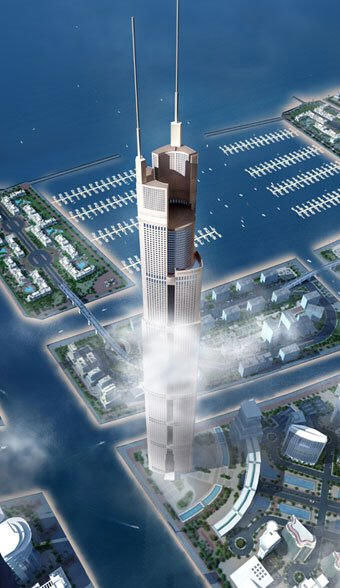 |
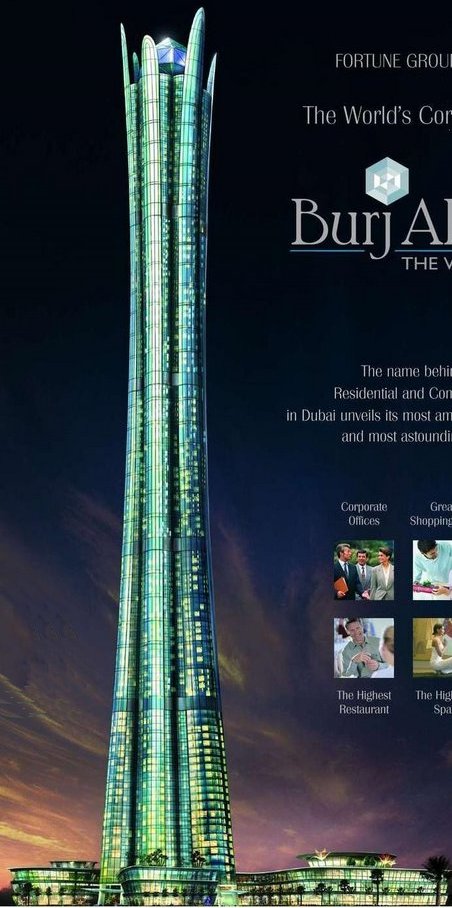
The Burj al Alam, or The World Tower. Upon completion
in 2009 it will rank as the world's highest hotel.
At 480 meters it will
be only 28 meters shorter than the
Taipei 101. |
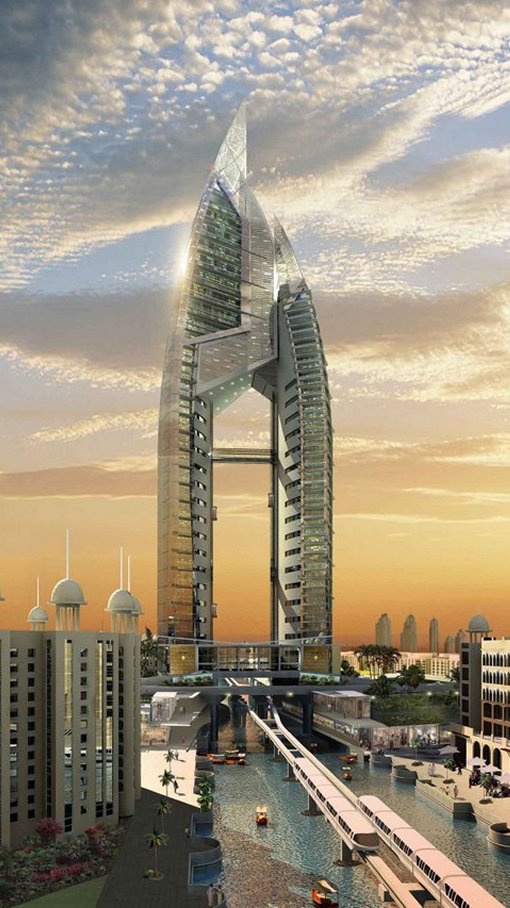
This is the proposed Trump International Hotel
& Tower. When completed, it will become
the centerpiece of one of the palm islands,
The Palm Jumeirah. |
|
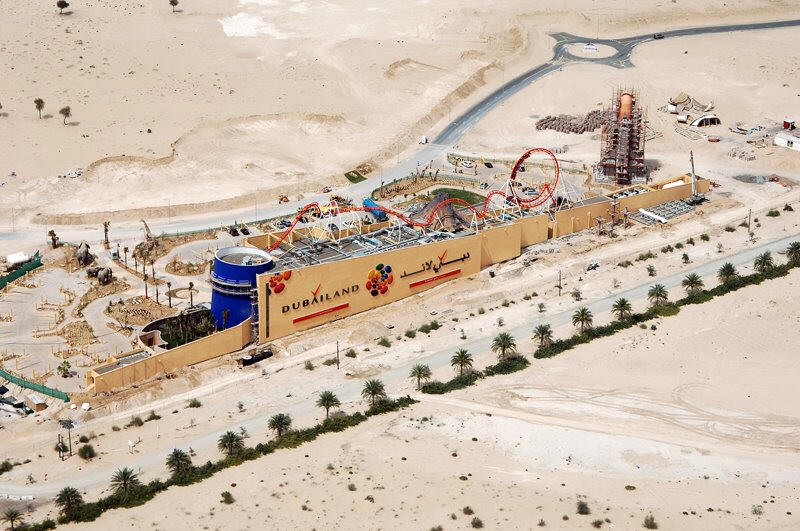 |
|
DUBAILAND
The Middle East's answer to Disneyland is a
monster project called Dubailand.
Dubailand will be built on 3 billion square feet (107 miles^2) at
an estimated $20 billion price tag. The site will include a
purported 45 mega projects and 200 hundred other smaller projects.
When it is finished, it will occupy an area
larger than the country of Monaco.
It will employ 300,000 people in the various
sectors,
which are expected to eventually service
15 million visitors. A new urban railway, with 37 stops, begins
construction soon.
|
|
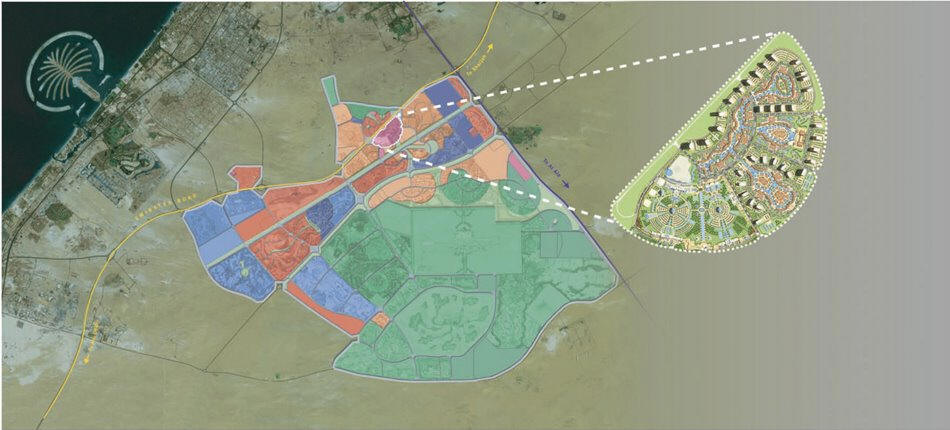 |
|
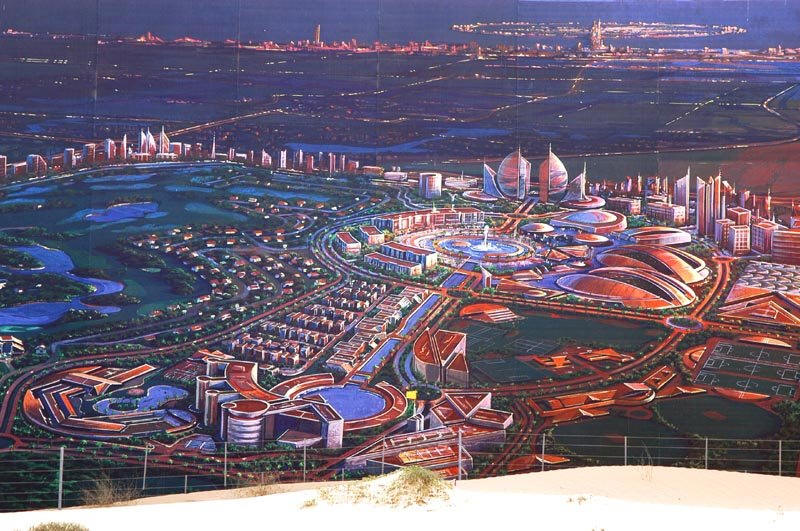 |
Currently, the largest amusement park collection in the world is
Walt Disney World Resort in Orlando, which is also the largest
single-site employer in the United states with 58,000 employees.
Dubailand will be twice the size
of Disneyworld.
Dubailand was the vision of Dubai's
former ruler Sheikh Mohammed bin Rashid Al
Maktoum.
The development is expected to be a full featured city divided into
six theme worlds. The short range goal of the Dubailand is to
attract 15 million tourists to Dubai by 2010. Developers
expect to accomplish this goal by creating a tourism, entertainment,
and leisure destination that will attract visitors not only from
surrounding countries but also from Europe and Asia. The venture is
expected to attract approximately 200,000 visitors daily and cost
$20 billion.
|
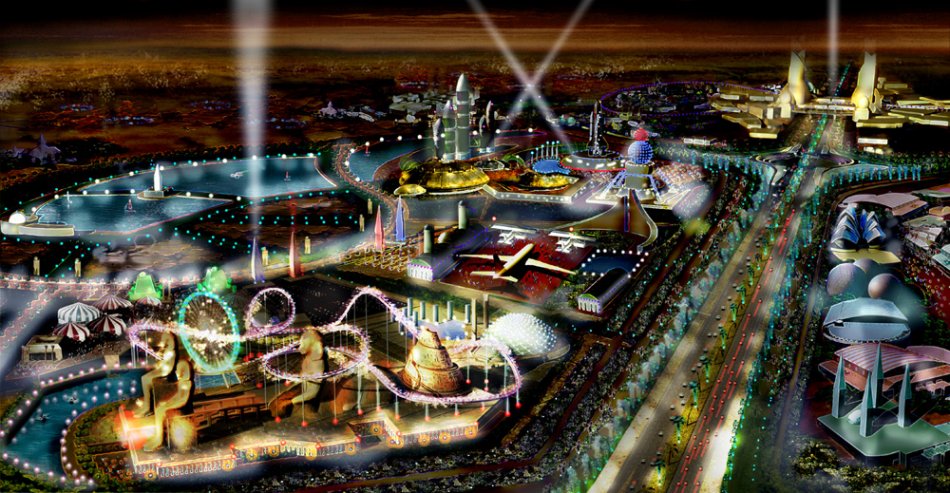 |
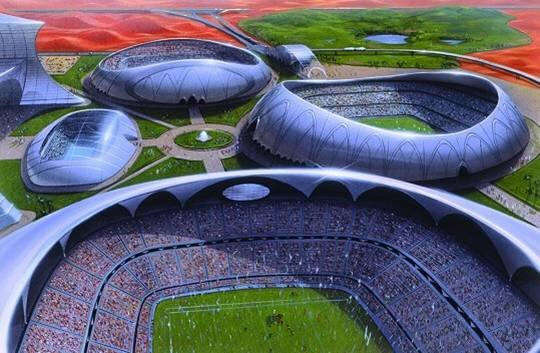 |
One section of Dubailand will be devoted to
sports.
In an area known as the Dubai Sports City, a huge collection of
sports arenas will be located in Dubailand.
Many believe Dubailand is a long-term plan to phase out the
city's dependence on oil revenues, though 95% of Dubai's annual GDP
comes from non-oil sectors such as tourism.
|
Currently, the Walt Disney World Resort is the #1 tourist
destination in the world. Once fully completed, Dubai land will
easily take over that title since it is expected to attract 200,000
visitors daily.
|
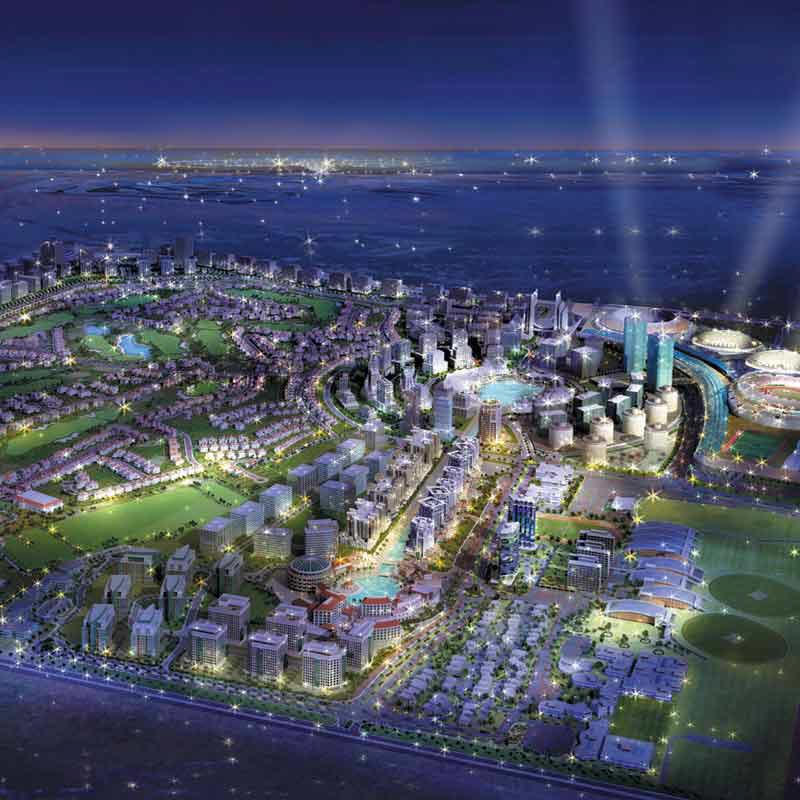 |
There's another side to Dubai. Drive south along the Gulf, away
from the glamour zone of the great hotels, past the giant malls and
the huge gas-fired power stations, almost to the western border of
Dubai, and you come to the largest man-made harbour in the world.
The unapproachably vast quays of the modern port at Jebel Ali
were dredged out of the desert sands in 1979 at a place where the
present emir's father, Sheikh Rashid, used to come for evenings
camping with his friends. Abdulla bin Damithan, one of the port
managers, showed me around in his red Audi. (This was a replacement;
the BMW was in for service.) The 1.5 mile-long quays are so enormous
that to look the length of them is to stare into a desert haze.
Halfway along, the metal bodies of the ships and cranes disappear
like mirages.
But it is no dreamy place: every minute, every towering gantry
crane lifts another container off the high-stacked decks of the
bulbous ships alongside, lowers it to a waiting truck that delivers
it to another part of the site, or transfers it from the
unimaginably huge motherships, which travel the world oceans, to the
slightly less huge feeder ships that service the Gulf, the Indian
trade and the Mediterranean. Nothing interrupts the movements, day
and night, 365 days a year, even in July at 90% humidity, an air
temperature usually over 49C and when even the seawater in the docks
approaches 38C. No one works outside. More than seven million
containers are moved here in the course of the year, a figure that
grew 23% last year, and is set to triple within the next six years,
serving a market of two billion people. It's like looking at the
guts of the world, the usually hidden machinery by which things
actually happen. Over on the other side of the harbour, two
diminutive destroyers are tied up, the stars and stripes hanging off
their sterns. This is where the American carrier battle groups
patrolling the Gulf come for service - and shopping. It's the port
most visited by the US navy outside the United States.
Like
almost everything of any significance in Dubai, the port system
belongs to the state, or to the Maktoums, the ruling family. The two
are indistinguishable, and in some ways, Dubai is like Poundbury
writ large - and rich: a princely vision of how the world might be.
The Maktoums came here as Bedouin chieftains in the 1820s, to a
small, palm-fringed trading creek, where political control was in
the hands of the British. Only in 1971 did Dubai gain independence
as part of the United Arab Emirates. It was already known that Abu
Dhabi, by far the biggest and richest of the Emirates, was sitting
on a vast mineral reserve. At current rates of production, Abu Dhabi
has more than 120 years' supply of oil and gas still untapped. Dubai
is nothing like so well endowed, and so from the 1960s onwards, the
Maktoums have been consciously shaping Dubai as the trading and
financial motor of the Emirates, and the Dubai ports system is
central to their vision.
|
This is the
American University
in Dubai.
It is a branch campus of the American InterContinental University in
Atlanta, Georgia, but is accredited regionally as a separate unit by the
Southern Association of Colleges and Schools. |
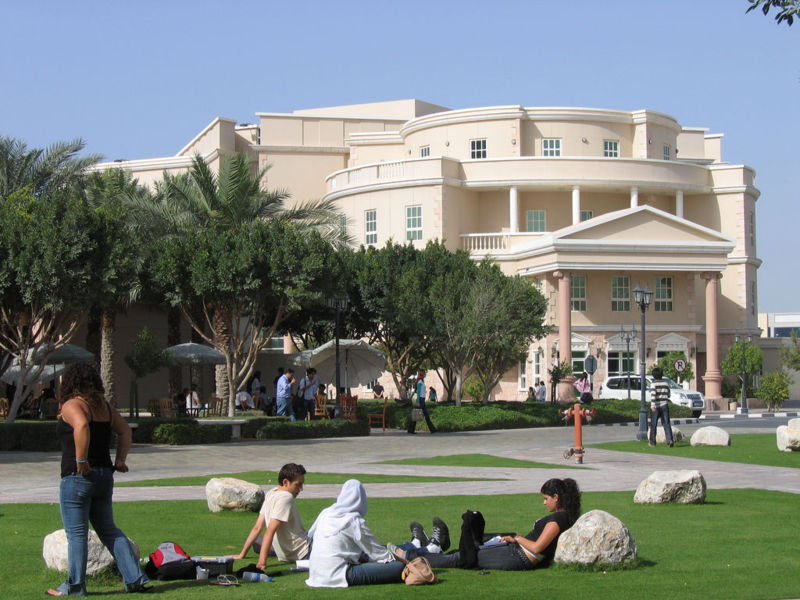 |
Dubai sits on the all-important strategic routeway of the modern
world: China, India, Middle East, Europe and the US. That is where
the money is going to be. China has just become the third biggest
economy in the world and it is the fastest growing. India is set for
its own acceleration. The Maktoum plan is to make Dubai the centre
of a global strategic network of port facilities to rival Singapore
and the huge Hong Kong-based conglomerate of Hutchison-Whampoa. They
have been acquiring hard and fast and now control massive facilities
in China, Hong Kong, Australia, South Korea, India, Yemen, Djibouti,
Saudi Arabia, Romania, Germany and Latin America.
In a profoundly symbolic move, Dubai Ports are now
maneuvering to make a bid for the great harbours in southern Iraq.
They want more, and that desire for global control is what lies
behind their bidding war for P&O, the British ports and shipping
combine, which has a powerful European presence (including the giant
London Gateway, planned to be Britain's biggest container port at
Thurrock on the Thames), exactly what Dubai wants. Singapore wanted
it too and the two commercial city states' rival bids drove up the
price, adding 80% to the value of P&O's shares and valuing the
company at a reported $6.8bn (just short of £4bn), an unprecedented
40 times P&O's profits last year. At the weekend, Singapore pulled
out and all the signs are that when P&O's shareholders vote today,
they will accept Dubai's offer. This bid alone is a measure of the
hunger, the money and the drive of what is happening in the emirate.
And the Arab world has backed the bid. When Dubai Ports issued a
bond for $2.8bn last month to help it buy P&O, it found itself
drowning in $11.4bn of subscriptions.
|
Aerial
Photograph
of
The World |
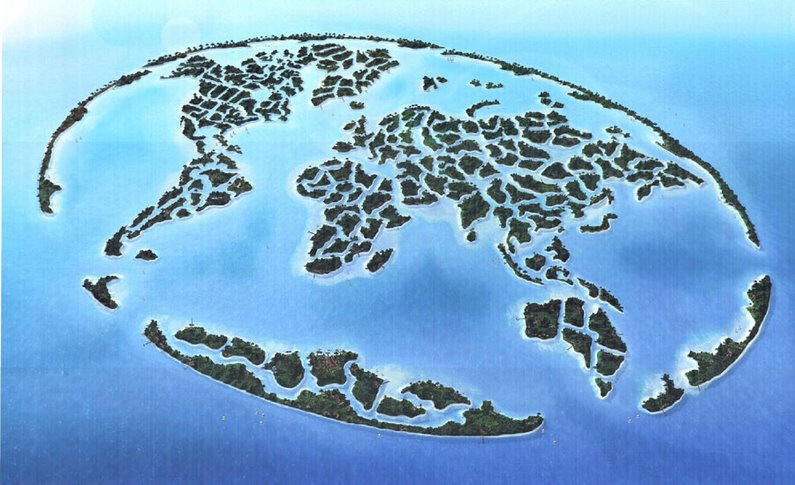 |
According to an
article in Wikipedia, The World is a man-made
archipelago of 300 islands in the shape of a world map
currently being built 4 km (2.5 miles) off the coast of
Dubai. The World is one of a
series of artificial island projects in Dubai, along with
the Palm Islands, and like the other islands The World is
being built primarily using sand dredged from the sea. The
only access to the islands is by boat, helicopter, or
seaplane. The World is being constructed by Nakheel
Properties and is the brainchild of Sheikh Mohammed bin
Rashid Al Maktoum, the ruler of Dubai
(died January 2006).
|
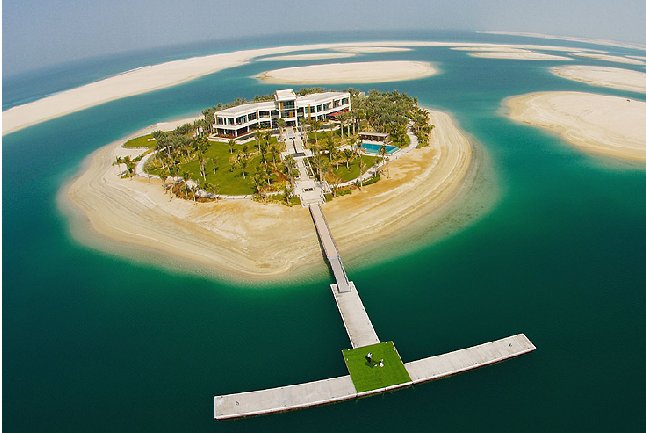 |
This is a photo showing one of the islands in The World
in Dubai, United Arab Emirates as seen from the air on 1 May
2007.
This is the first island that had a structure
built on it. This island
is being used as a model island
for prospective buyers.
Each island ranges from about 14,000 square metres
(150,000 square feet) to 42,000 square metres (450,000
square feet).
Each island will have an estimated cost of $25-30
million.
|
The distance between each island will be an average of
100 metres (328 feet). The entire development will cover an
area of 9 km in length and 6 km in width, surrounded by an
oval breakwater. 232 km (144 miles) of shoreline will be
created upon completion.
According to the National Geographic Channel (Best of
Megastructures) the overall price for the World is 14
billion USD. As for the individual islands, prices range
between 15 and 45 million USD.
Dredging for the project began in 2004. By May 2007, 45% of
the islands had been sold, 20 of which were bought in the
first four months of 2007. As of early October 2007, land
reclamation was "nearly complete" and was expected to be
finished in 2008. Once that occurs, owners will be able to
construct their own developments and properties.
|
Why is Dubai doing this? And why so
fast? What can the hunger be traced to?
I spent a morning on The World, one of the big prestige projects,
consisting of 300 artificial islands made of sand dredged from the
sea floor and either dumped or pumped into forms that vaguely mimic
the shape of the world's continents. Every week between five and 10m
cubic metres of sand are delivered to the site. The islands will
cost up to $30m each, and that is for the sand alone. Making the
lumps habitable for the world's island-hungry rich will cost half as
much again.
I was somewhere in Greenland with Hamza Mustafa, the man who is
running it for Nakheel, the state-owned developer. It was another
invented moment: we were there for a photo. Vijay Singh, the Fijian
golfer, was going to fire some shots from Greenland over a narrow
channel to Iceland, still nothing but sand, on which one of
Nakheel's PR men had put a golf flag. There were helicopters,
artificial grass, English marketing girls, Singh's personal trainer
in shorts, his agent in shades, two photographers, their assistants,
cooks, waiters and barmen, boatmen, people from a Nakheel golf
development and Singh's personal course designer, who told me in
detail how sewage makes courses greener. It's a perfect symbiosis:
houses need golf courses and golf courses need the sewage the houses
produce. How happy is that? "As long as it's got the nutrients,
grass loves sand," he said.
While Singh stood beneath the chopper firing his shots, I talked to
Mustafa, in the sleek Arab-modernist villa he's had built on
Greenland. He has already sold 30% of the $3bn project, mostly to
"local money, from the region", the rest, he says, to British and
Americans. Australasia has been sold to a developer from Kuwait. Why
are they buying? "No tax, good weather, an easy life, a comfortable
life, affordable. I don't have to push the sales. I've got 10
islands left of the ones I want to sell at the moment. They are
clamouring for them. And then I'll stop for a while. We don't want a
glut." He smiled, complicit, knowing as well as I did what sales
talk amounts to. "By 2015, there will be 250,000 people living here.
It'll be like Venice."
I asked him why Dubai was going through this world-busting surge.
One might have expected the straightforward business answer, which
goes something like this: Dubai, unlike other parts of the Gulf, has
little of its own oil or gas. A great deal of Arab money, invested
in the US, came back from there after 9/11 and needed an outlet. The
fact that oil is now pushing $70 a barrel means that the Gulf is
awash with liquidity. There is clearly a role for a strategic
financial centre in the Middle East: Beirut played it once, Dubai
could do so now. Money has been draining out of Iran for years and
Dubai, just across the Gulf, has always been a traditional place for
Iranians to put their money to work. Mohammed Noor Taleb, a
75-year-old textile trader I spoke to in the souk, who had lived
with his mother as a child in a tent made of palm leaves and now
owned a business in Indian cottons turning over $5.2m a year, told
me an old Dubai joke. A young boy is asked by his father "What is
two add two?" "Am I buying or am I selling?" the boy says. Commerce
is in the blood.
But Mustafa's reply came from another place entirely, evidence of
the extraordinary hybridisation of cultures that is going on here:
traditionalist, modernist, Arabist, internationalist, market-based,
bowing to authority. For Mustafa, it all stems from the Emir of
Dubai himself, Sheikh Mohammed bin Rashid al-Maktoum. Mohammed only
became Emir on January 4, when his elder brother Sheikh Maktoum bin
Rashid al-Maktoum, died after a long illness. But Mohammed has had
his hand on the tiller for years. "Sheikh Mohammed has had a
vision," Mustafa said, "which is that Dubai should become a fully
developed city, with the best life of any city that has ever been
created. The whole city is growing as a single organism. We have
planned this, very carefully, he is a leader who has bestowed a
great vision on us, so that in time Dubai is going to become the
first ever Arab modern metropolis." Was this really about an Arabist
dream of perfection? "No, this is not Arab nationalism. But what
Dubai is trying to do is set an example of how Arabs should be
represented. After 9/11, Arabs suffered from a lot of bad publicity.
Dubai is trying to come back with the right kind of publicity. It
will be a fully modern state. It will be setting the standards. It
will be a place that people will look up to."
You might have to take that with a few bucketloads of salt. There is
no hint of democracy in Dubai. There is a consultative council whose
members are nominated by the ruling family. A group of five old Arab
families control the entire emirate. The working and living
conditions of the construction labourers and the domestic servants
from south Asia are notoriously bad. Thirty-nine building workers
died on sites last year, 22 of them simply by falling, as provision
of slings and ropes is inadequate. The Dubai press is full of
stories criticising companies for late payment, no payment, the
confiscation of passports, imposition of penalties for minor
infringements, the manoeuvrings of loan sharks and all the other
expectable abuses of a poorly regulated employment system. The
property laws are explicitly racist: no non-UAE national can own
land outside the designated free zones. No foreign company can
operate in the country without paying a UAE "sponsor" to be their
local representative. No one except UAE nationals can get one of the
plum jobs in a government department. Education and healthcare are
free for all UAE nationals but no one else. The local press will
never be seen to criticise the government and when, for example, I
tried to interview the director of strategic planning in the offices
of Dubai municipality, I was told I could only do so "if we have
checked you out first and seen that what you will write will be
favourable". Not much hybridisation there.
And yet it is not Saudi Arabia. Brokeback Mountain is soon to open
in Dubai cinemas, which it never could in Saudi Arabia. There is no
problem with bikinis and sunbathing on the beaches. And on a more
substantial level, there is a determined effort to de-monopolise the
economy, to make market competition the driver for this new model
world. Local customs must be respected: no loud music during
Ramadan, no eating in front of Muslims on fast days, no possibility
of making a political claim on the direction of the state. And in
return for those limits, the state delivers a sense of wellbeing.
That is the trade-off on which Dubai is relying. A booming market,
with a consciously courteous social culture and a tight police
system (panic buttons in the thousand gold shops in old Dubai bring
the police in two minutes) deliver a better wage than would be
available at home - all this in return for surrendering anything
resembling a political right.
Eduardo Ferrari, an Argentinian cameraman who has lived in Dubai for
the last eight years, says he couldn't "give a damn for democracy. I
live here in the most democratic country in the world. Why? Because
the economy is taking you by the tip of your head and pulling you
up. Every year I have more and more. In Argentina, every year I have
less and less." Vishal Khemani, a 26-year-old from Mumbai, who
imports Indian and Japanese textiles for Dubai wholesalers, says he
loves Dubai simply because it is "very disciplined, very neat, very
clean. Everything is going to timetable. I have a good job, good
food. It is a cheap country." And extremely safe. There has been no
hint, so far, of any terrorist attack, although you would have
thought it was due for one. A western businessman, surveying the
most luxurious of the Jumeirah beach hotels, said simply to me:
"Everything about this place smells of western women, right? It
looks like an al-Qaida target to me." There are rumours in Dubai
that a terror plot was foiled last year but the processes of
government are so opaque that there is no confirming that. It may be
that the levels of government control in Dubai are high enough to
make any terrorist operations very difficult.
Bob Gogel, CEO of Liberata, an international company specialising in
the outsourcing of financial services, probably speaks for the
business community as a whole. "Dubai is an unpolished gem polishing
itself very quickly. You could look at it as a CD compilation - the
best of London, Sydney, Miami, Las Vegas - and you have to give them
the benefit of the doubt. Where else in the Middle East is going to
do it? Turkey? Saudi Arabia? Lebanon? Egypt? Kuwait? You can't see
it. Nowhere in the world do you get such good service. Certainly not
in London. And business people like that. They've got a good plan,
it's tightly controlled, they've managed to pull in some good
people, they've got the oil money, and that price is not going to
drop very far. The property market in Dubai is probably overheated
and the Dubai stock market is due for a correction. But you try
poking holes and I have trouble poking that big a hole."
This is the Dubai sandwich: at the bottom, cheap and exploited Asian
labour; in the middle, white northern professional services, plus
tourist hunger for glamour in the sun and, increasingly, a
de-monopolised western market system; at the top, enormous
quantities of invested oil money, combined with fearsome social and
political control and a drive to establish another model of what
modern Arabia might mean in the post-9/11 world.
That is the intriguing question: can Dubai do what Libya, Egypt,
Palestine, Lebanon, Syria, Iraq, Yemen, or almost anywhere else in
the Arab world you might like to mention, have failed to do?
Is Dubai, in fact, the fulcrum of the
future global trading and financial system? Is it, in embryo, what
London was to the 19th century and Manhattan to the 20th? Not the
modern centre of the Arab world but, more than that, the Arab centre
of the modern world.
|
|